LEXUS RX350 2011 Owners Manual
Manufacturer: LEXUS, Model Year: 2011, Model line: RX350, Model: LEXUS RX350 2011Pages: 821, PDF Size: 13.27 MB
Page 171 of 821
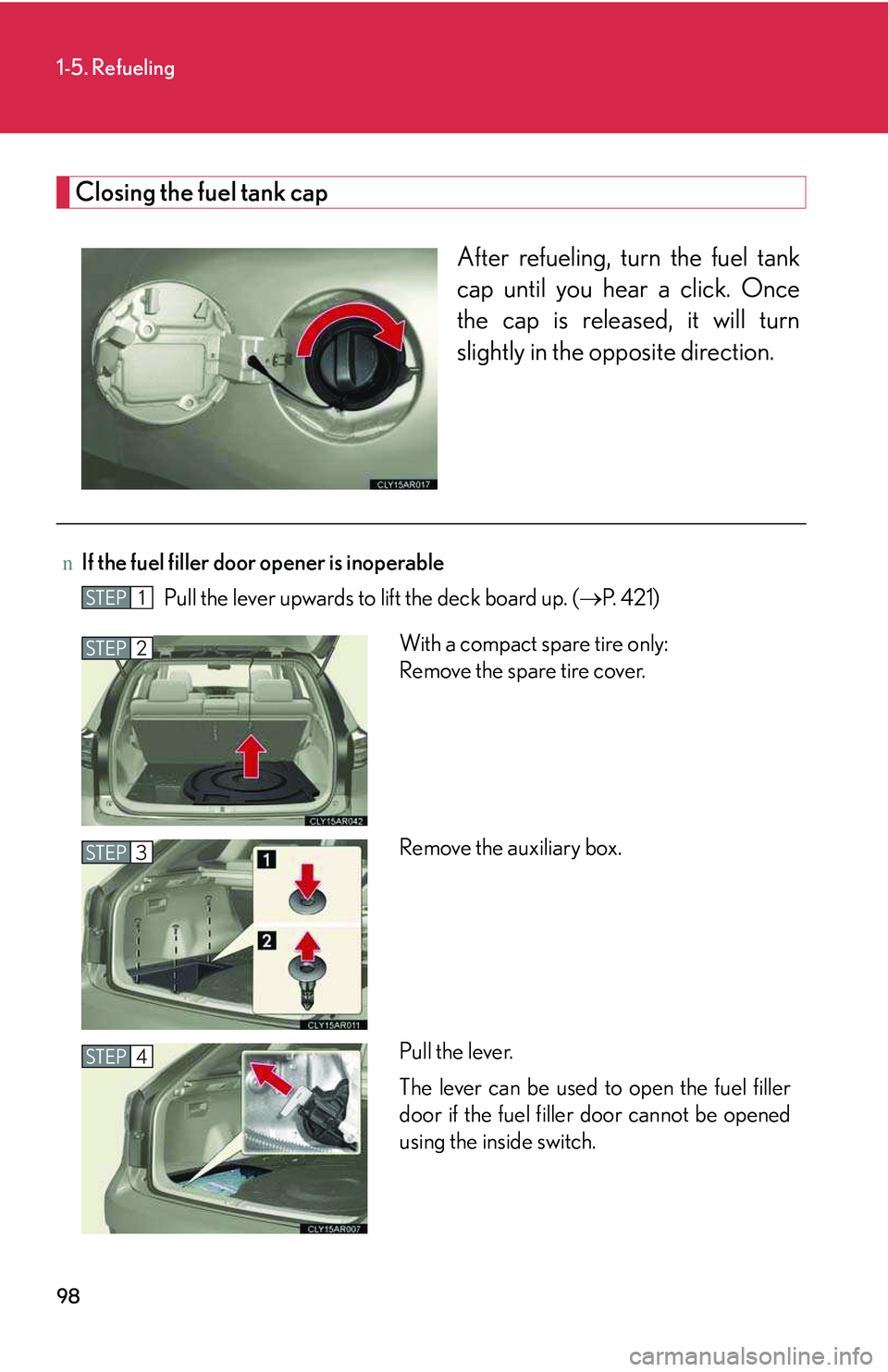
98
1-5. Refueling
Closing the fuel tank cap
After refueling, turn the fuel tank
cap until you hear a click. Once
the cap is released, it will turn
slightly in the opposite direction.
nIf the fuel filler door opener is inoperable
Pull the lever upwards to lift the deck board up. (�→P. 4 2 1 )STEP1
With a compact spare tire only:
Remove the spare tire cover.
Remove the auxiliary box.
Pull the lever.
The lever can be used to open the fuel filler
door if the fuel filler door cannot be opened
using the inside switch.
STEP2
STEP3
STEP4
Page 172 of 821
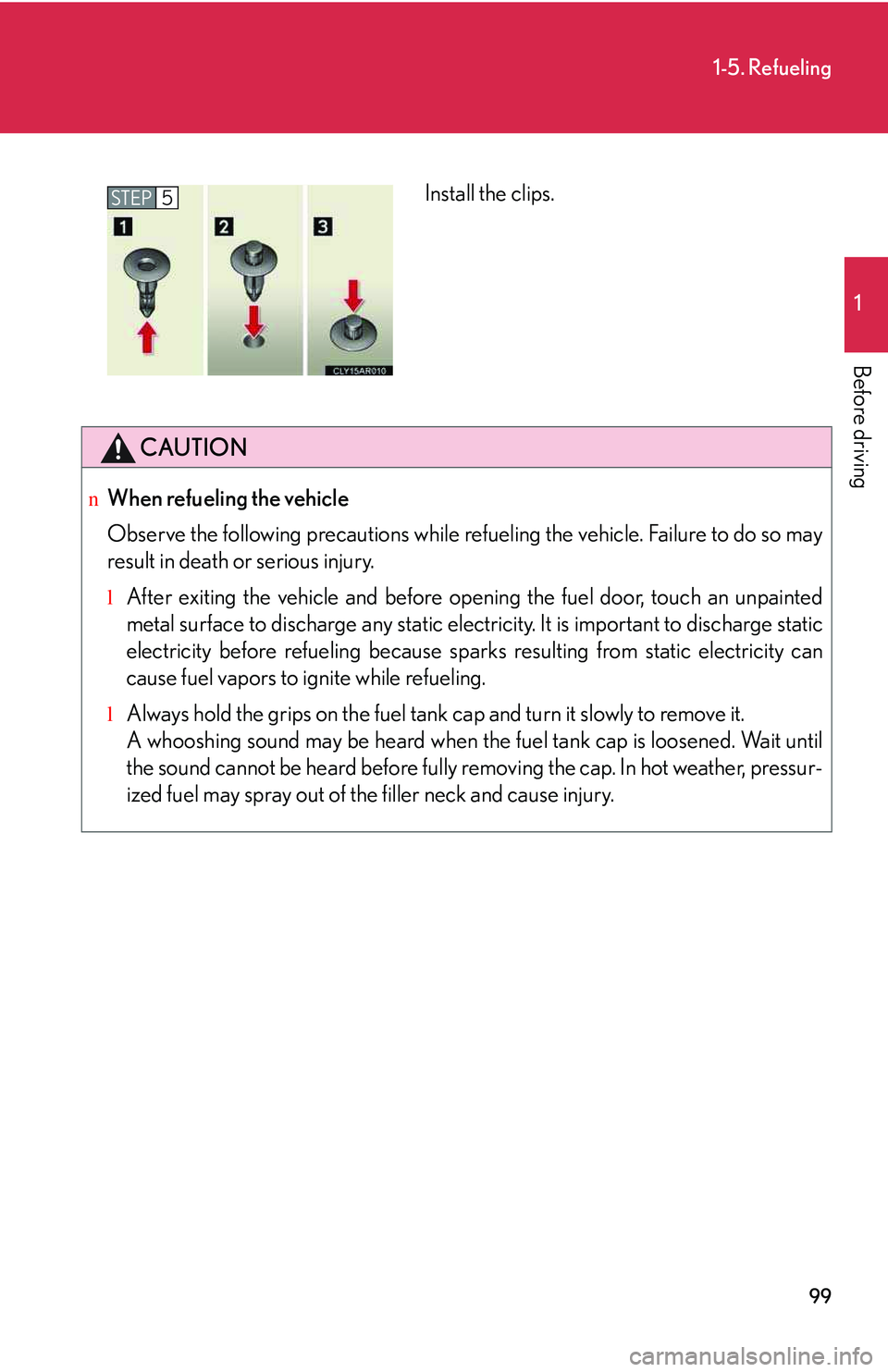
99
1-5. Refueling
1
Before driving
CAUTION
nWhen refueling the vehicle
Observe the following precautions while refueling the vehicle. Failure to do so may
result in death or serious injury.
lAfter exiting the vehicle and before opening the fuel door, touch an unpainted
metal surface to discharge any static electricity. It is important to discharge static
electricity before refueling because sparks resulting from static electricity can
cause fuel vapors to ignite while refueling.
lAlways hold the grips on the fuel tank cap and turn it slowly to remove it.
A whooshing sound may be heard when the fuel tank cap is loosened. Wait until
the sound cannot be heard before fully removing the cap. In hot weather, pressur-
ized fuel may spray out of the filler neck and cause injury.
Install the clips.STEP5
Page 173 of 821
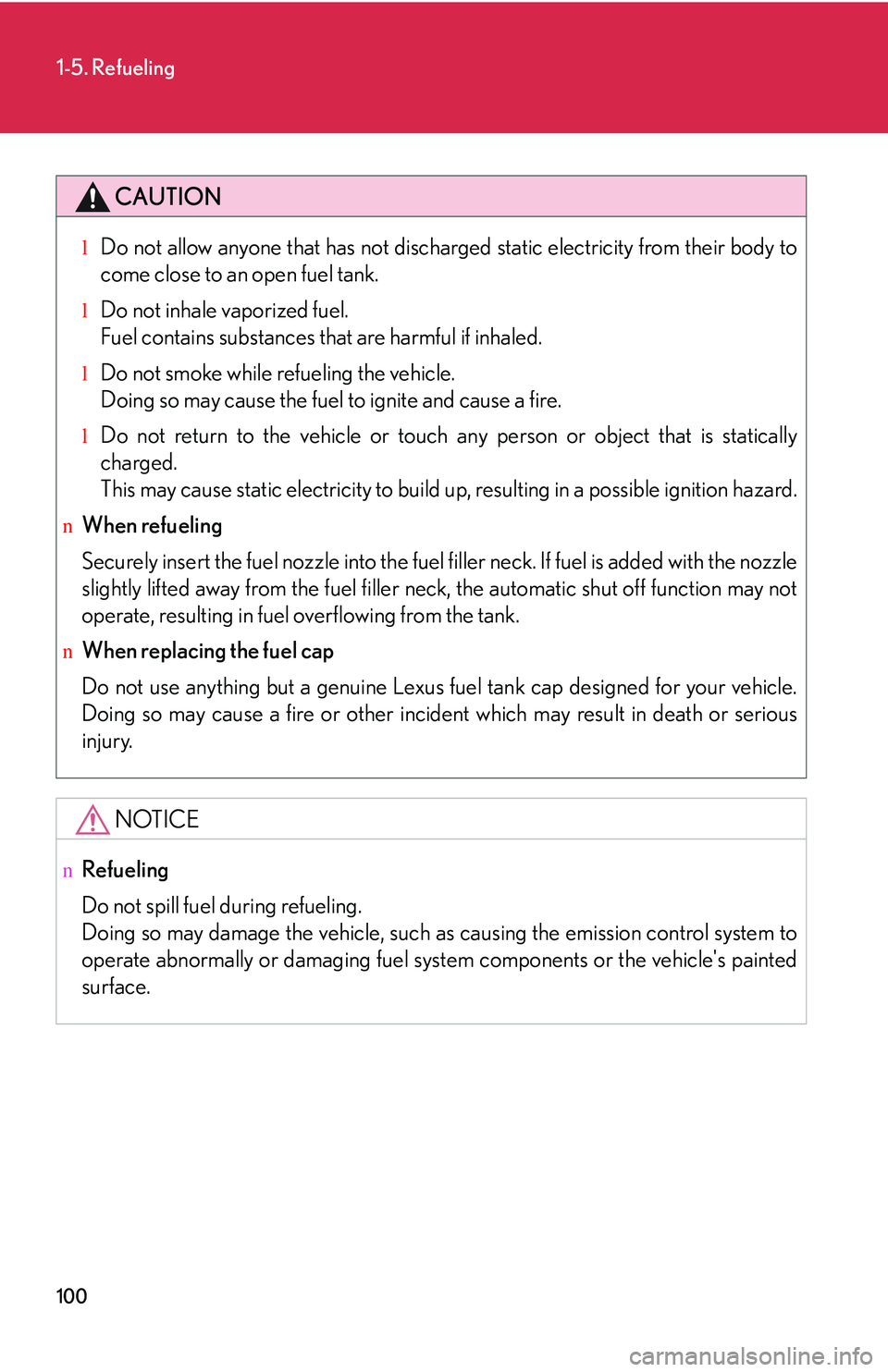
100
1-5. Refueling
CAUTION
lDo not allow anyone that has not discharged static electricity from their body to
come close to an open fuel tank.
lDo not inhale vaporized fuel.
Fuel contains substances that are harmful if inhaled.
lDo not smoke while refueling the vehicle.
Doing so may cause the fuel to ignite and cause a fire.
lDo not return to the vehicle or touch any person or object that is statically
charged.
This may cause static electricity to build up, resulting in a possible ignition hazard.
nWhen refueling
Securely insert the fuel nozzle into the fuel filler neck. If fuel is added with the nozzle
slightly lifted away from the fuel filler neck, the automatic shut off function may not
operate, resulting in fuel overflowing from the tank.
nWhen replacing the fuel cap
Do not use anything but a genuine Lexus fuel tank cap designed for your vehicle.
Doing so may cause a fire or other incident which may result in death or serious
injury.
NOTICE
nRefueling
Do not spill fuel during refueling.
Doing so may damage the vehicle, such as causing the emission control system to
operate abnormally or damaging fuel system components or the vehicle's painted
surface.
Page 174 of 821
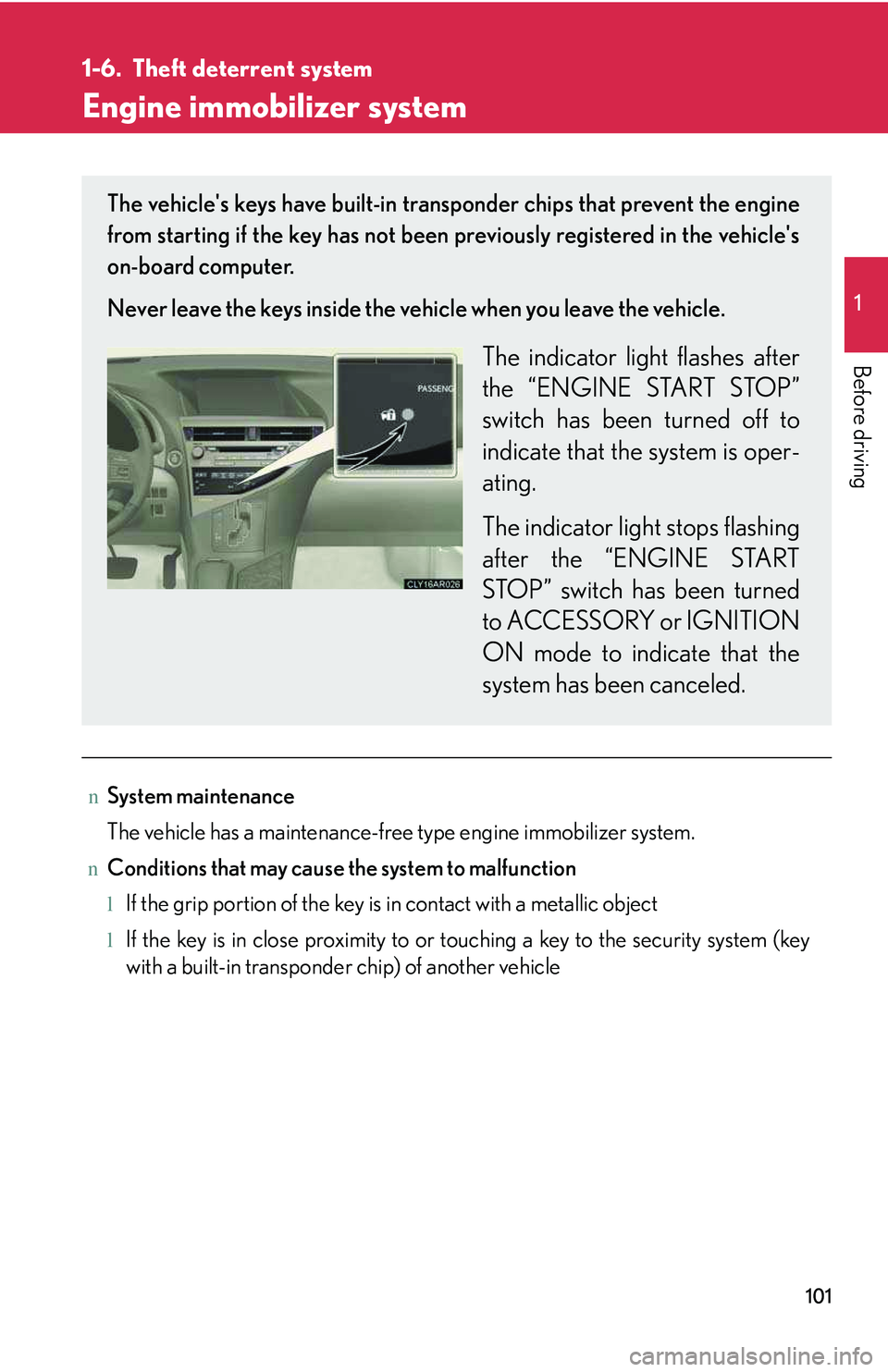
101
1
Before driving
1-6. Theft deterrent system
Engine immobilizer system
nSystem maintenance
The vehicle has a maintenance-free type engine immobilizer system.
nConditions that may cause the system to malfunction
lIf the grip portion of the key is in contact with a metallic object
lIf the key is in close proximity to or touching a key to the security system (key
with a built-in transponder chip) of another vehicle
The vehicle's keys have built-in transponder chips that prevent the engine
from starting if the key has not been previously registered in the vehicle's
on-board computer.
Never leave the keys inside the vehicle when you leave the vehicle.
The indicator light flashes after
the “ENGINE START STOP”
switch has been turned off to
indicate that the system is oper-
ating.
The indicator light stops flashing
after the “ENGINE START
STOP” switch has been turned
to ACCESSORY or IGNITION
ON mode to indicate that the
system has been canceled.
Page 175 of 821
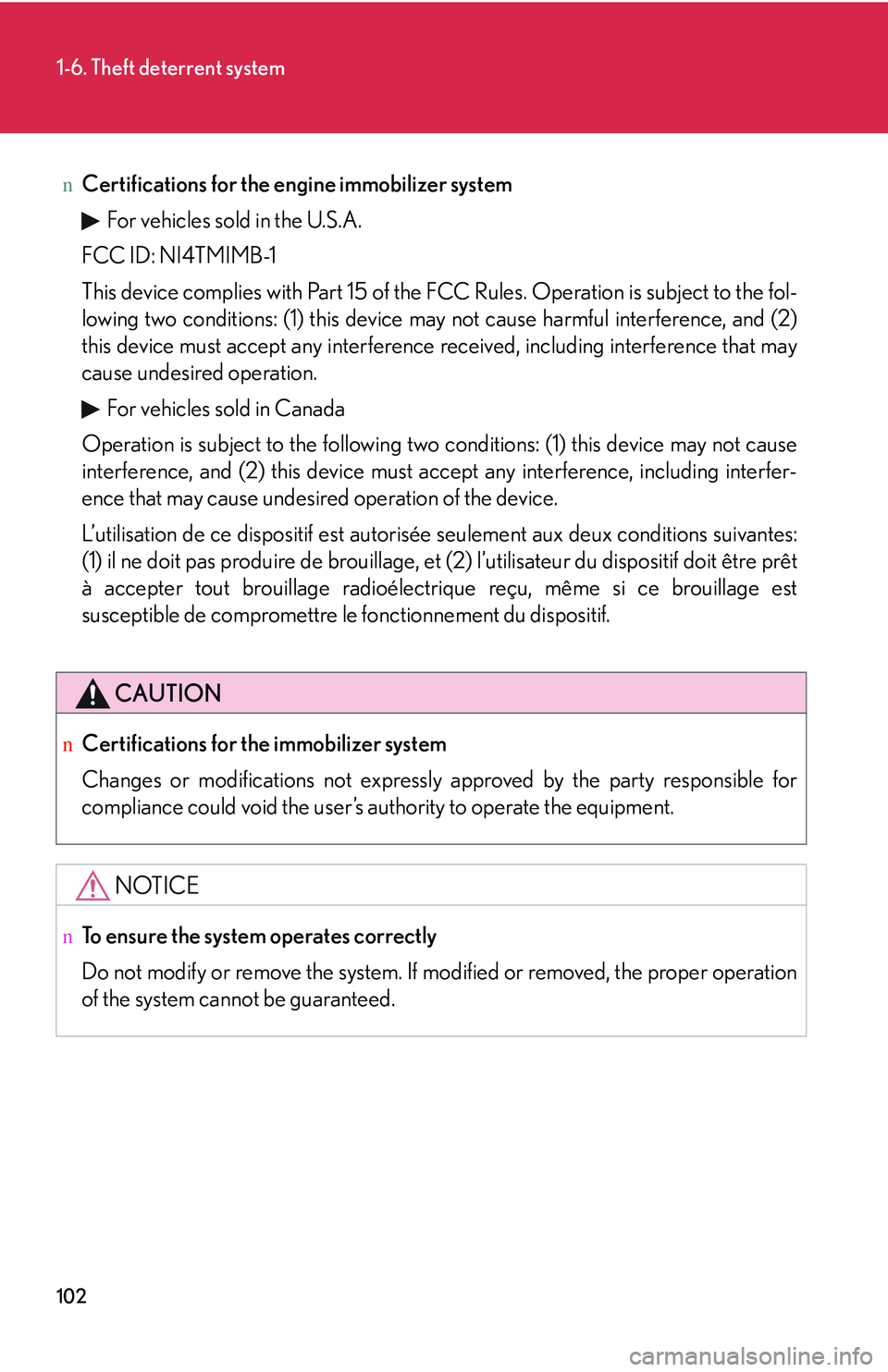
102
1-6. Theft deterrent system
nCertifications for the engine immobilizer system
For vehicles sold in the U.S.A.
FCC ID: NI4TMIMB-1
This device complies with Part 15 of the FCC Rules. Operation is subject to the fol-
lowing two conditions: (1) this device may not cause harmful interference, and (2)
this device must accept any interference received, including interference that may
cause undesired operation.
For vehicles sold in Canada
Operation is subject to the following two conditions: (1) this device may not cause
interference, and (2) this device must accept any interference, including interfer-
ence that may cause undesired operation of the device.
L’utilisation de ce dispositif est autorisée seulement aux deux conditions suivantes:
(1) il ne doit pas produire de brouillage, et (2) l’utilisateur du dispositif doit être prêt
à accepter tout brouillage radioélectrique reçu, même si ce brouillage est
susceptible de compromettre le fonctionnement du dispositif.
CAUTION
nCertifications for the immobilizer system
Changes or modifications not expressly approved by the party responsible for
compliance could void the user’s authority to operate the equipment.
NOTICE
nTo ensure the system operates correctly
Do not modify or remove the system. If modified or removed, the proper operation
of the system cannot be guaranteed.
Page 176 of 821
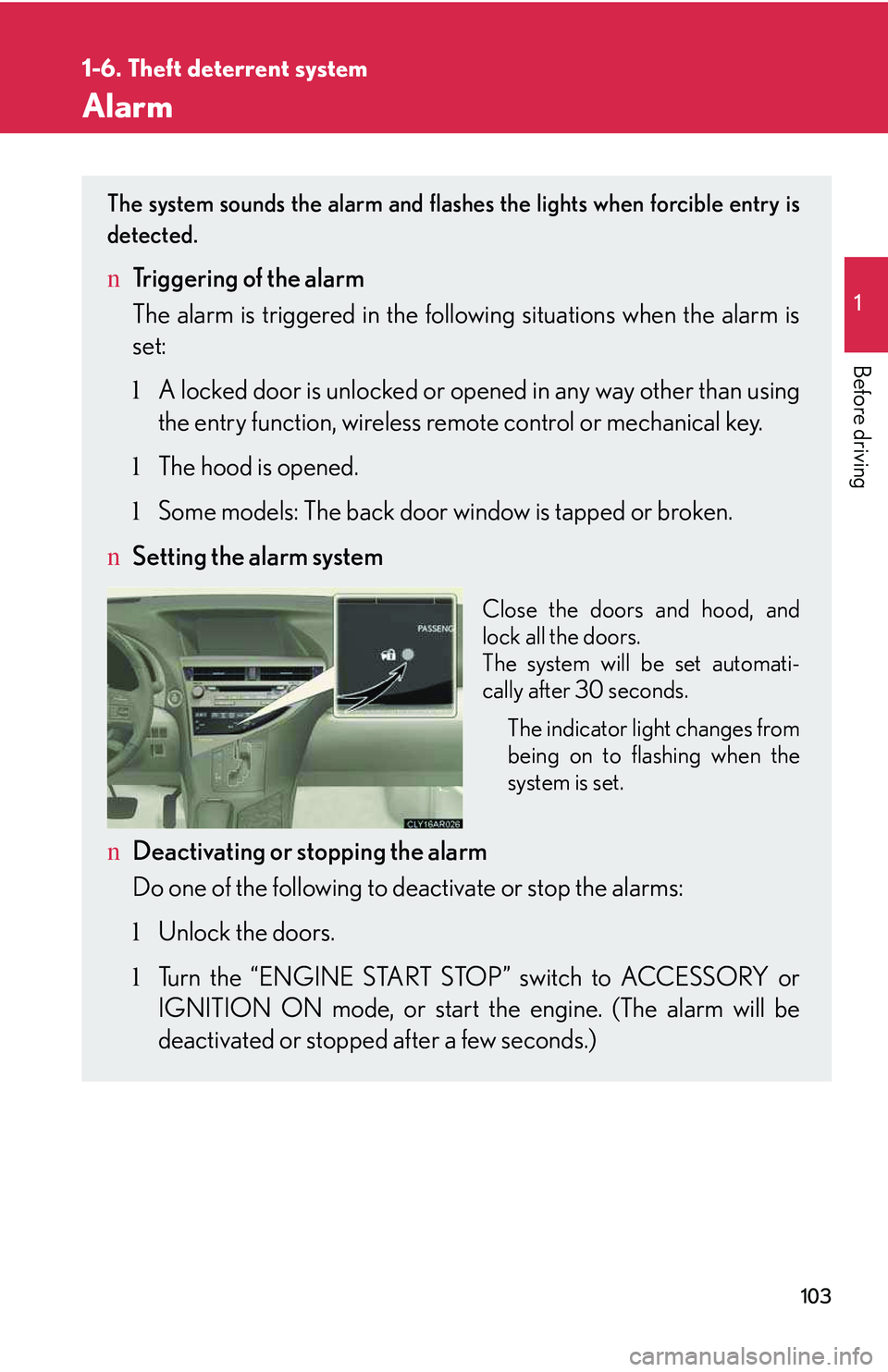
103
1
1-6. Theft deterrent system
Before driving
Alarm
The system sounds the alarm and flashes the lights when forcible entry is
detected.
nTriggering of the alarm
The alarm is triggered in the following situations when the alarm is
set:
lA locked door is unlocked or opened in any way other than using
the entry function, wireless remote control or mechanical key.
lThe hood is opened.
lSome models: The back door window is tapped or broken.
nSetting the alarm system
Close the doors and hood, and
lock all the doors.
The system will be set automati-
cally after 30 seconds.
The indicator light changes from
being on to flashing when the
system is set.
nDeactivating or stopping the alarm
Do one of the following to deactivate or stop the alarms:
lUnlock the doors.
lTurn the “ENGINE START STOP” switch to ACCESSORY or
IGNITION ON mode, or start the engine. (The alarm will be
deactivated or stopped after a few seconds.)
Page 177 of 821
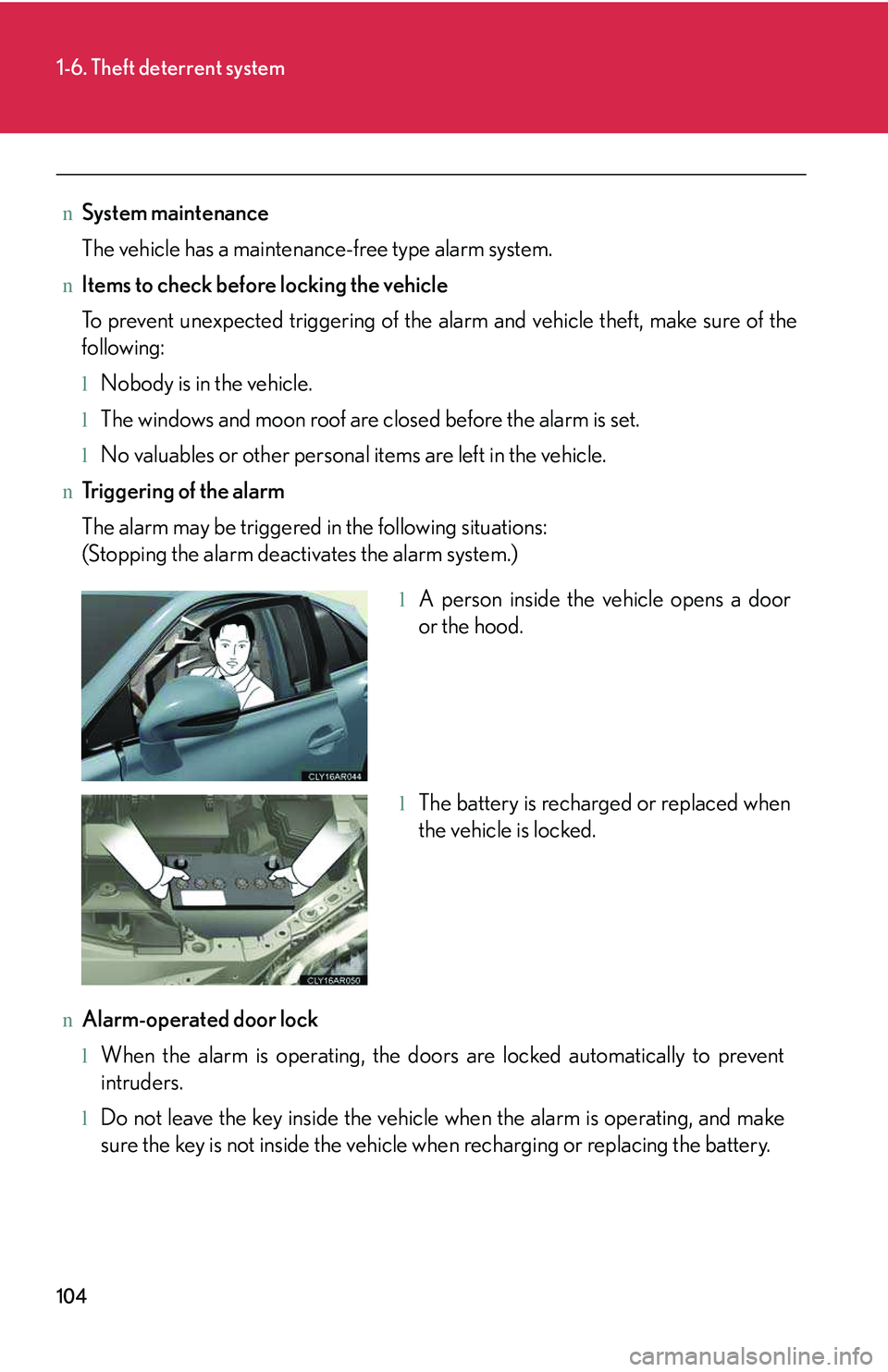
104
1-6. Theft deterrent system
nSystem maintenance
The vehicle has a maintenance-free type alarm system.
nItems to check before locking the vehicle
To prevent unexpected triggering of the alarm and vehicle theft, make sure of the
following:
lNobody is in the vehicle.
lThe windows and moon roof are closed before the alarm is set.
lNo valuables or other personal items are left in the vehicle.
nTr i g g e r i n g o f t h e a l a r m
The alarm may be triggered in the following situations:
(Stopping the alarm deactivates the alarm system.)
nAlarm-operated door lock
lWhen the alarm is operating, the doors are locked automatically to prevent
intruders.
lDo not leave the key inside the vehicle when the alarm is operating, and make
sure the key is not inside the vehicle when recharging or replacing the battery.
lA person inside the vehicle opens a door
or the hood.
lThe battery is recharged or replaced when
the vehicle is locked.
Page 178 of 821
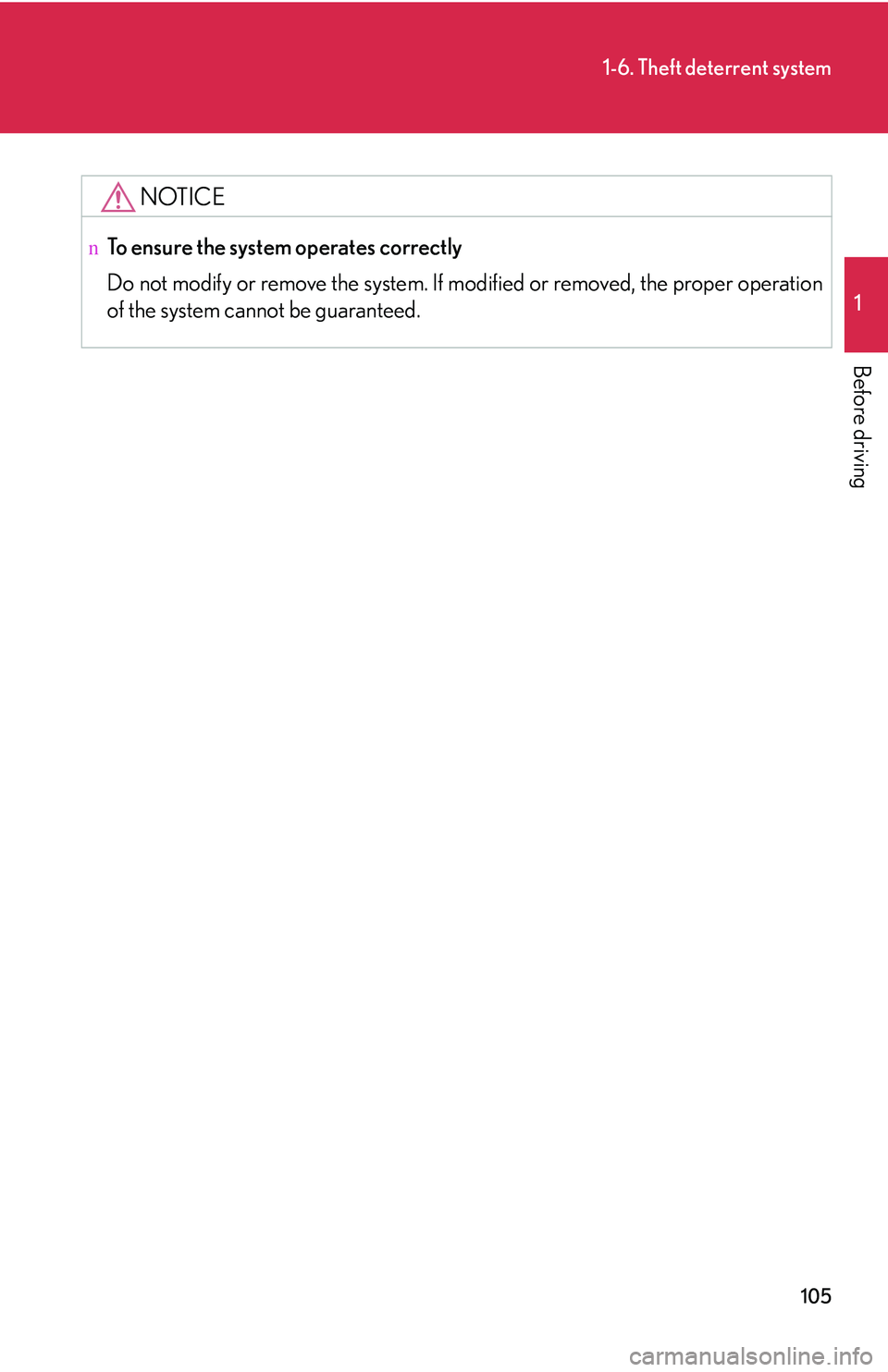
105
1-6. Theft deterrent system
1
Before driving
NOTICE
nTo ensure the system operates correctly
Do not modify or remove the system. If modified or removed, the proper operation
of the system cannot be guaranteed.
Page 179 of 821
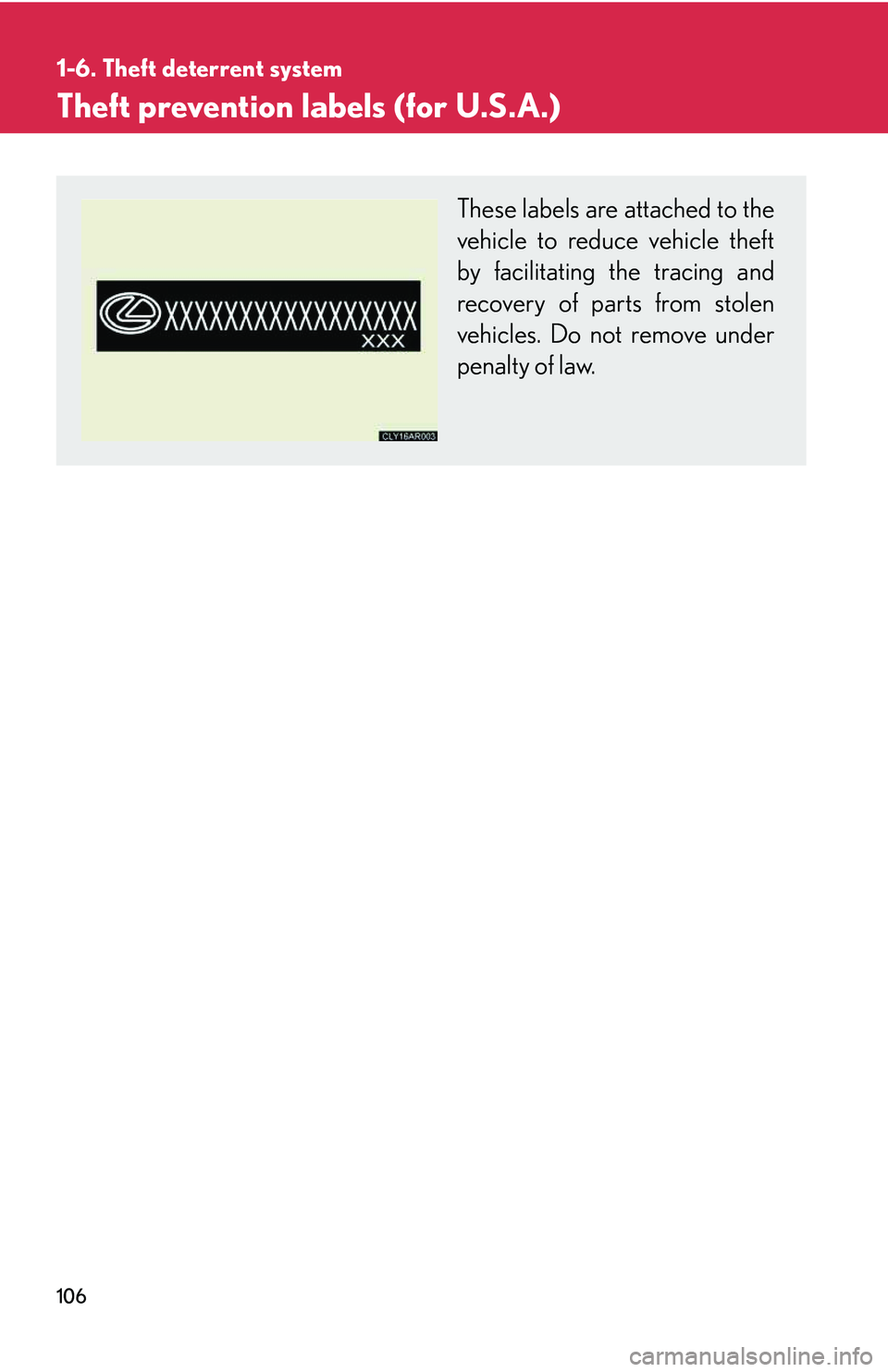
106
1-6. Theft deterrent system
Theft prevention labels (for U.S.A.)
These labels are attached to the
vehicle to reduce vehicle theft
by facilitating the tracing and
recovery of parts from stolen
vehicles. Do not remove under
penalty of law.
Page 180 of 821
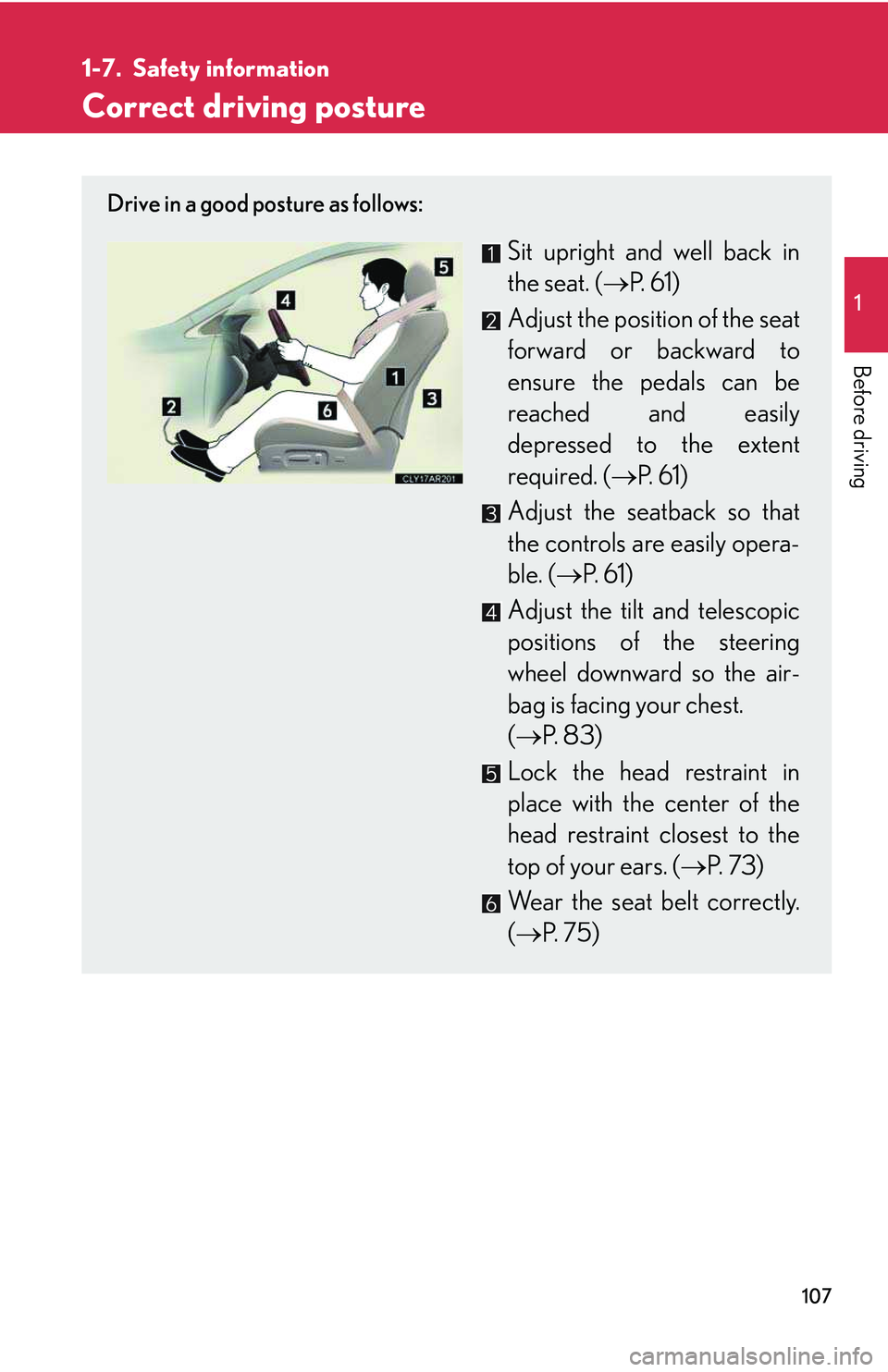
107
1
Before driving
1-7. Safety information
Correct driving posture
Drive in a good posture as follows:
Sit upright and well back in
the seat. (�→P. 6 1 )
Adjust the position of the seat
forward or backward to
ensure the pedals can be
reached and easily
depressed to the extent
required. (�→P. 6 1 )
Adjust the seatback so that
the controls are easily opera-
ble. (�→P. 6 1 )
Adjust the tilt and telescopic
positions of the steering
wheel downward so the air-
bag is facing your chest.
(�→P. 8 3 )
Lock the head restraint in
place with the center of the
head restraint closest to the
top of your ears. (�→P. 7 3 )
Wear the seat belt correctly.
(�→P. 7 5 )